
| January 2001 | ||||||
| Sun | Mon | Tue | Wed | Thu | Fri | Sat |
| 1 | 2 | 3 | 4 | 5 | 6 | |
| 7 | 8 | 9 | 10 | 11 | 12 | 13 |
| 14 | 15 | 16 | 17 | 18 | 19 | 20 |
| 21 | 22 | 23 | 24 | 25 | 26 | 27 |
| 28 | 29 | 30 | 31 | |||
At 0800 Atlantic Standard Time, the Training Ship Empire State intended to be underway and steering various courses and speeds as she piloted out of Willemstad, Curacao. The weather was pleasant; air temperature 82 degrees and water temperature 78 degrees Fahrenheit; skies were mostly clear; winds were from the East at 11 knots; barometric pressure was 1016 millibars. Relative humidity was 78%. Depth of water beneath the keel was 30 feet. The morning was perfect for departure. However, that did not occur.
CAPTAIN'S LOG
Optimism is the tendency to anticipate the best possible outcomes in all situations and it is essential if one hopes for success at sea. Nothing deals with stress like an optimistic outlook, and besides, no one likes a whiner. Therefore, it is with great enthusiasm that I report, we will sail at 0800 Wednesday, 31 January 2001.
First, I know that everyone is concerned about the cadets. They are fine and performing as we have learned to expect. They are planning a two on two, basketball tournament, and jousting matches for this evening's entertainment while they continue to be the crucial elements in the work force.
Now you ask, why are we here? You guessed it. The turbo generator failed the twenty-four hour load test. After nineteen hours of normal operation, the overspeed trip activated and stopped the machine. We isolated the cause to a failure in the overspeed mechanisms and the Chief Engineer and his crew are working to remedy it. When complete, he will place the electric load or the generator and run through out the night. Remember, we have auxiliary generators and my staff and I are considering the options.
We plan to be in St. Thomas this weekend, and pier space is confirmed. Therefore, we will not go to anchor as initially planned. Going to the dock makes life infinitely easier for all concerned as boat crews and launches are not necessary to place people ashore. The transit north, will be busy as we fill every hour with underway training opportunities that are difficulty to replicate in port. But, that makes life more interesting and provides more oportunities to excel.
Well folks, I regret being so brief today, but management team meetings are next; we have much to do and I must go. Cheer for us. See you tomorrow.
P.S. Just to show you that work and training have been going on during our entire stay here in Curacao, I've attached some proof. Run your browser over the photos and you will get some details of each shot. My "thanks" to the photographers; 2/c Megan Kearns and 3/c Angela Abbot.
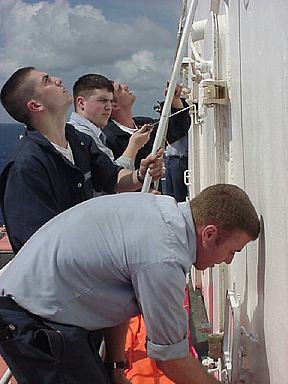
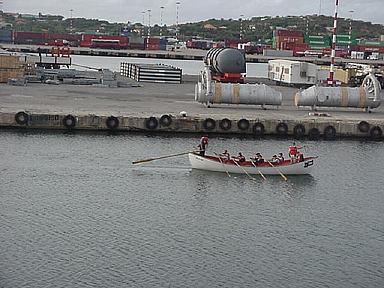
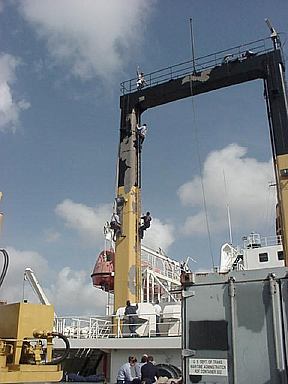
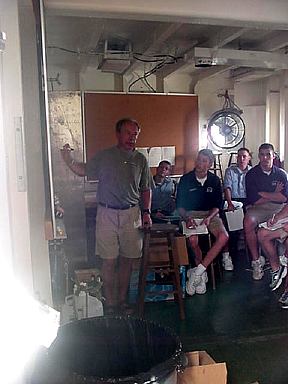
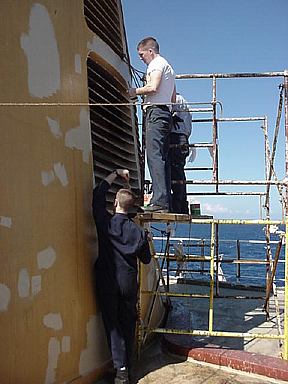
QUESTIONS FOR WEDNESDAY 31 JANUARY
MATH:
The temperature aboard the Empire State in the Caribbean is 32 degrees Centigrade. At the same time, the temperature at Massachusetts Maritime Academy is 32 degrees Fahrenheit. What is the difference in temperature between the two locations? Express your answer in degrees Fahrenheit.
SCIENCE:
Earthquakes are a common problem in the Caribbean Basin. What instrument is commonly used to record the direction, duration, and strength of earthquakes?
GEOGRAPHY:
The Cadets will "fix the ship's position" at sea by using a system of geometrical coordinates on the surface of the earth. This system, which gives the location of a place north or south of the equator, is expressed by angular measurements ranging from 0° at the equator to 90° at the poles, and east or west of a north-south line called the prime meridian, measured in angles ranging from 0° at the prime meridian to 180° at the International Date Line. These "grid" coordinates are called Parallels of__________ and Meridians of ___________. Where are the Prime Meridian and the International Date Line located?
HISTORY:
Earthquakes are frequent occurrences throughout the world. When did the latest large earthquake occur in Central America? At what magnitude was the quake measured? In what country did it occur?
ANSWERS FOR TUESDAY 30 JANUARY
MATH:
2200/47 = 46.80
SCIENCE:
Distillation process. (Boil and condense).
Reverse osmosis. (Filtration).
GEOGRAPHY:
The Lithosphere is the earth's outer crust.
HISTORY:
The Netherlands was awarded possession of Curacao in 1815.